Raised On YouTube
Growing plants with the light of algorithmically selected Internet video
From the Hanging Gardens of Babylon to the contemporary green walls, plants have fascinated us. We enjoy rooting for plants—they make us happy. But even as our appreciation of plant biology has grown over time, our relationship to them has become distorted. Our culture is the culprit. Profligate and destructive, culture's growth becomes nature's loss. It is an ecology of imbalance: What pleases us, pollutes them.
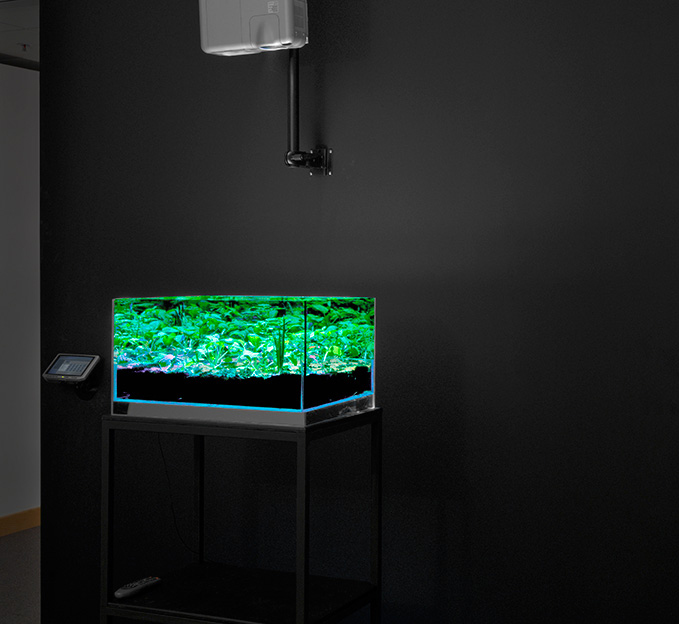 As food, as medicine, as material, it was plants that once shaped mankind. But no longer. What new ecologies are needed?
As food, as medicine, as material, it was plants that once shaped mankind. But no longer. What new ecologies are needed?
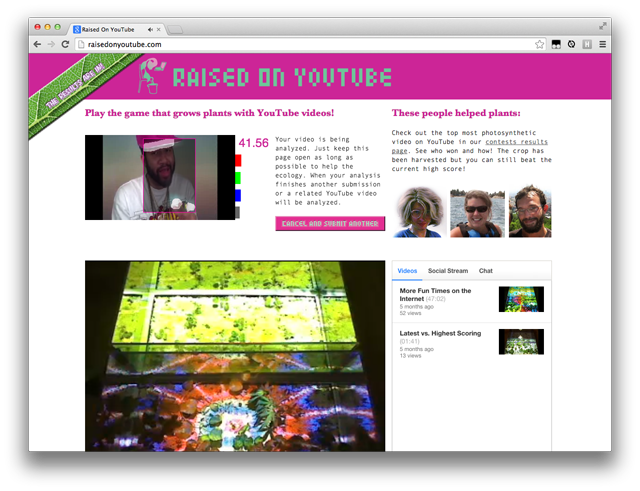 Raised On YouTube is a web-enabled ecology game. Players compete to submit the most photosynthetic video while contributing their computer power to crowd-sourced video analysis.
Raised On YouTube is a web-enabled ecology game. Players compete to submit the most photosynthetic video while contributing their computer power to crowd-sourced video analysis.
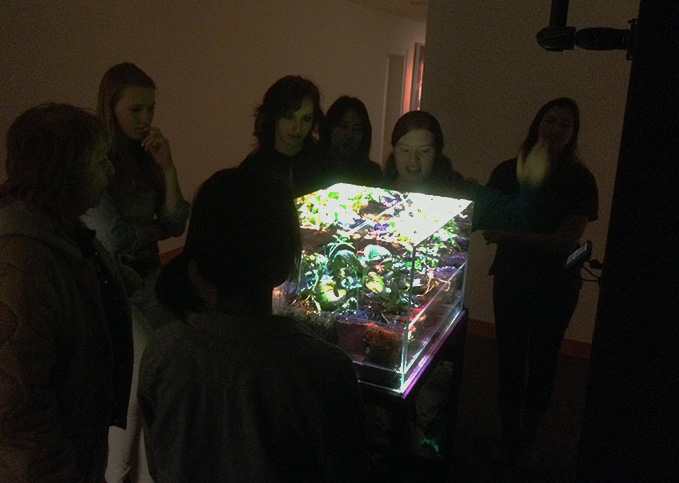 Plants grow and thrive under the dynamic light and sound of digital culture. The chaos of YouTube’s communal pool becomes a form of concentrated nourishment—pop culture and nature tethered together acting as fertilizer. Housed in a terrarium built with two-way mirrors and broadcast via web video, rows of crops dance in the pink noise and flickering lights of a culture overflowing with information. What pleases us, pleases them.
Plants grow and thrive under the dynamic light and sound of digital culture. The chaos of YouTube’s communal pool becomes a form of concentrated nourishment—pop culture and nature tethered together acting as fertilizer. Housed in a terrarium built with two-way mirrors and broadcast via web video, rows of crops dance in the pink noise and flickering lights of a culture overflowing with information. What pleases us, pleases them.
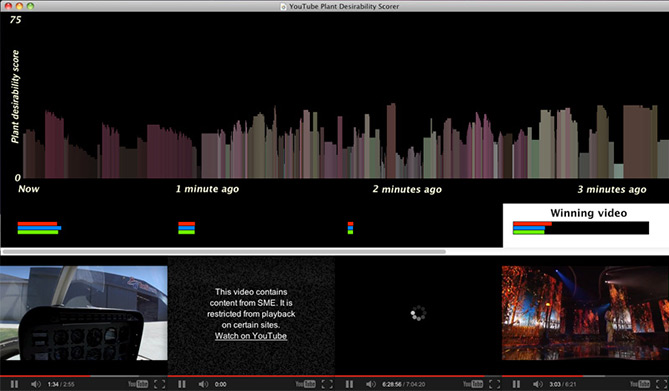 Every minute, YouTube amasses a hundred hours of video—more videos than could possibly be watched. What a waste! What a dump! Using a filtering algorithm, the system dives into the heap to weed the culture and prune the harvest. Custom software spiders through user submitted videos, scouring the haystack for video clips with the most nourishing color movement ratios and the pinkest noise.
Every minute, YouTube amasses a hundred hours of video—more videos than could possibly be watched. What a waste! What a dump! Using a filtering algorithm, the system dives into the heap to weed the culture and prune the harvest. Custom software spiders through user submitted videos, scouring the haystack for video clips with the most nourishing color movement ratios and the pinkest noise.
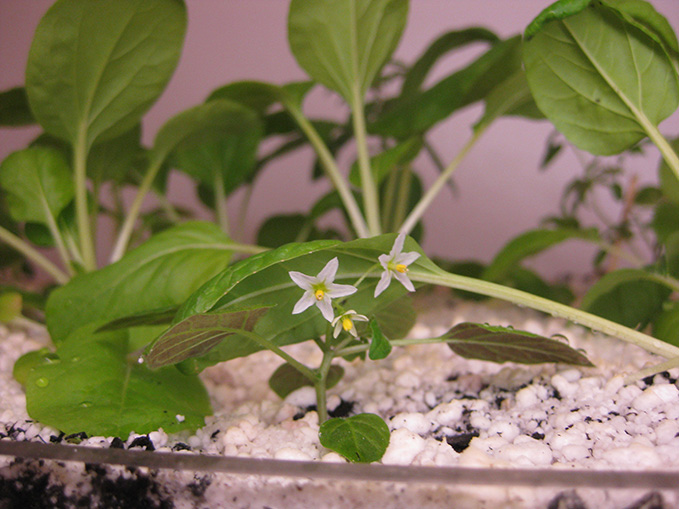 This botanical remix contains only the best light frequencies, feeding the plants only what they like. When the time comes, the plants, raised to maturity by YouTube, will be circulated into the supply of food for the players to eat and relish. And then, who knows, maybe some will return to the Internet to post a new video.
This botanical remix contains only the best light frequencies, feeding the plants only what they like. When the time comes, the plants, raised to maturity by YouTube, will be circulated into the supply of food for the players to eat and relish. And then, who knows, maybe some will return to the Internet to post a new video.
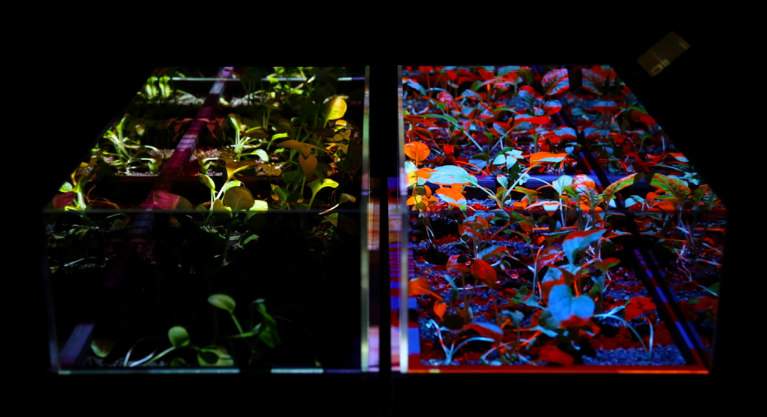 This new radical ecology experimental platform allows for video contests. Two identical setups allow for a control group and an experimental group of vegetables. One group can be grown with one set of video, and the other group with another set. Thus video can compete on the basis of plant desirability and growth.
This new radical ecology experimental platform allows for video contests. Two identical setups allow for a control group and an experimental group of vegetables. One group can be grown with one set of video, and the other group with another set. Thus video can compete on the basis of plant desirability and growth.
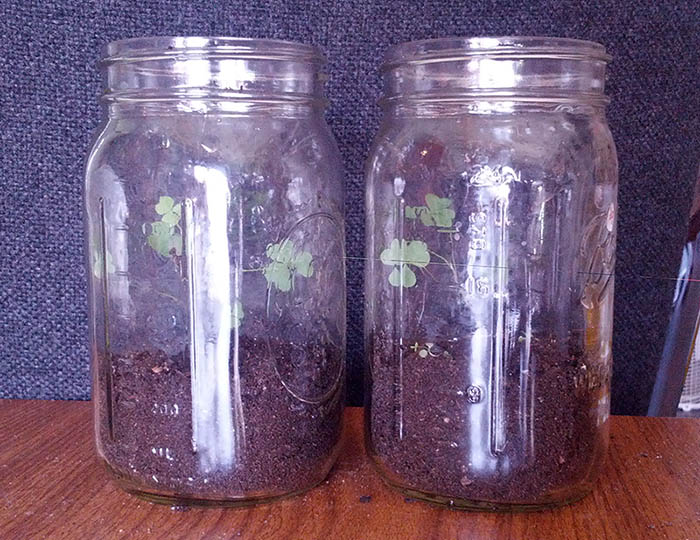 Plants could be trained to recognize political bias in video. If republicans always wear red colors (red ties, red dresses), and democrats wear blue colors consistently, we could look at the plants and know what TV channels they have been watching. I started with two clover plants born into the sunlight of Queens, New York, and I planted them separately.
Plants could be trained to recognize political bias in video. If republicans always wear red colors (red ties, red dresses), and democrats wear blue colors consistently, we could look at the plants and know what TV channels they have been watching. I started with two clover plants born into the sunlight of Queens, New York, and I planted them separately.
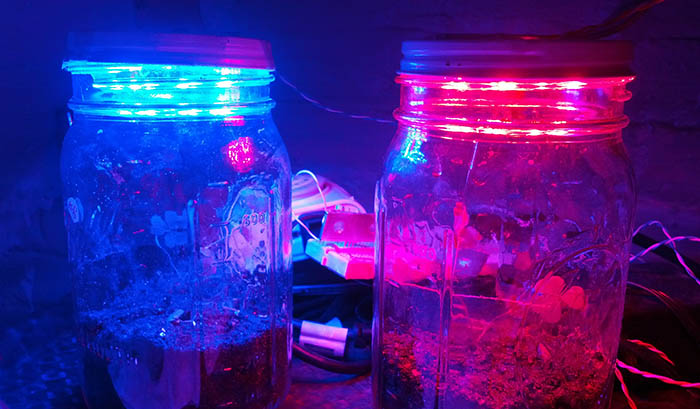 I made two grow lights using bright Red and Blue LEDs. The LEDs ran on a timer: 18 hours on, 6 hours off. I wanted to see if the clovers, which started out quite similar in size and shape, would diverge when growing under opposite light frequencies. After all it is chlorphyll b that absorbs blue light while red frequencies stimulate chlorophyll a.
I made two grow lights using bright Red and Blue LEDs. The LEDs ran on a timer: 18 hours on, 6 hours off. I wanted to see if the clovers, which started out quite similar in size and shape, would diverge when growing under opposite light frequencies. After all it is chlorphyll b that absorbs blue light while red frequencies stimulate chlorophyll a.
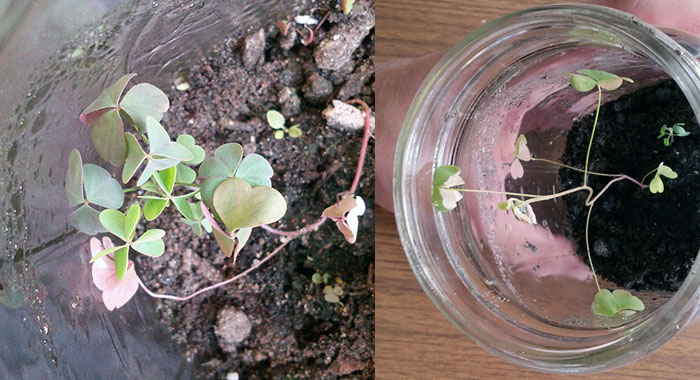 Plant biology is such that red light makes them shoot up but blue light creates short internodal distances. In the photo above you see the blue-raised clover on the left and the red-raised clover on the right after 10 days of growth. I speculate that plants shown a lot of US Democrat party video will be more bushy and distributed horizontally, while the GOP watching plants will be leggy with individualistic leaves.
Plant biology is such that red light makes them shoot up but blue light creates short internodal distances. In the photo above you see the blue-raised clover on the left and the red-raised clover on the right after 10 days of growth. I speculate that plants shown a lot of US Democrat party video will be more bushy and distributed horizontally, while the GOP watching plants will be leggy with individualistic leaves.
Additional photography by Joe Roggenbuck, David Broda, and Andrew Saluti.
